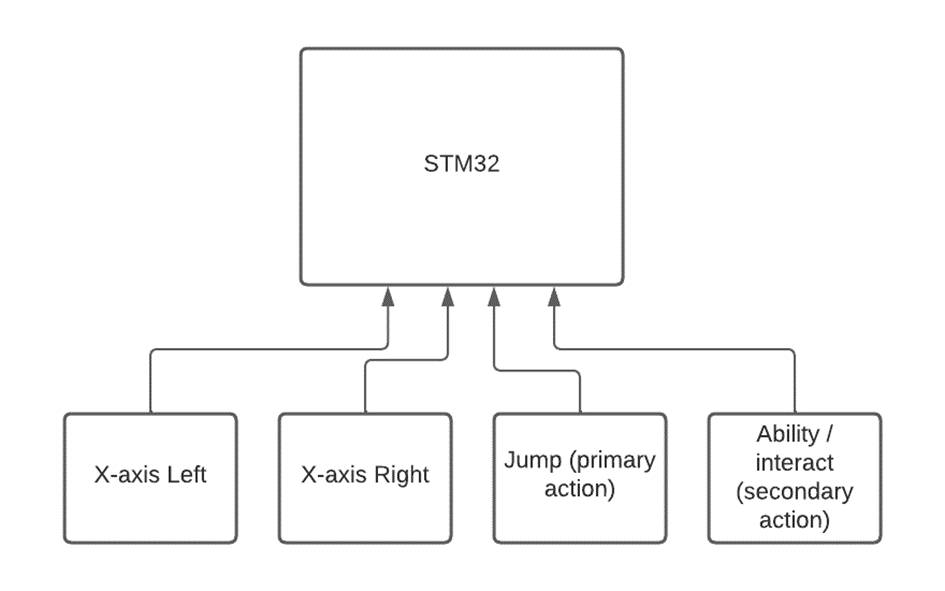diff options
| -rw-r--r-- | docs/architecture.md | 29 | ||||
| -rw-r--r-- | docs/research.md | 48 |
2 files changed, 76 insertions, 1 deletions
diff --git a/docs/architecture.md b/docs/architecture.md index 1af2383..3452862 100644 --- a/docs/architecture.md +++ b/docs/architecture.md @@ -10,6 +10,35 @@ Important notes: # Game controllers +## Input +The playable character has 4 actions that it can perform: +- movement on the x-axis (left / right) +- jump +- ability / use +To perform these action there will be 4 buttons for the user to use. + +A joystick is not needed for the movement because the movement is not complex, so button fulfill this. +The layout will be as follows: + + + +## Input handling: +The hardware consist out of a microcontroller and a FPGA. +The microcontroller will process the game logic. +For this reason the input will be handled by the microcontroller as this will improve playability (stated in research). + +The controller will have four buttons, so 4 data pins are needed on the microcontroller plus a ground and 3.3V or 5V pin. +In total there are 6 pins needed. +If the game is going to be played by 2 person, there are 4 more data pins needed so 8 data pins for both controllers. +For data transfer between STM32 and FPHA there are 4 pins needed at maximum (SPI for instance). +The STM32 will be used and most STM32 boards have enough I/O pins for our needs. +The STM32 F030 and F091 provided by AVANS both have 15 digital pins and 6 analog pins. +The buttons will be connected as follows: + + + +To implement the input in the game, the input should be ckecked at the start of each game cycle. In this case there are no interupts needed. + # STM32 software The game engine will be designed to support 2D games. The engine will use a state machine to manage game states and transitions between them. The state machine will be implemented using a finite state machine (FSM) design pattern. The engine will also include support for handling user input, game logic, and sound. diff --git a/docs/research.md b/docs/research.md index a3e86ff..682ed43 100644 --- a/docs/research.md +++ b/docs/research.md @@ -98,7 +98,7 @@ int main() { setup(); while(1) loop(); } - +``` # Generating audio signals In order to generate sound for this project, a few posibilities exist (see chapters below) @@ -204,3 +204,49 @@ There are a lot of ways of creating tiles and sprites for pixel art. Underneath | Asesprite | https://www.aseprite.org/ |Yes | pixel art | +# Input +The playable character has 4 actions that it can perform: +- movement on the x-axis +- jump +- ability / use + +To control these actions there has to be at least 4 inputs. +These can either be a button or joystick. +The actions can be done as follows: + +| Action | Button | Joystick | +| ------ | ------ | -------- | +| Movement x-axis| x | x | +| Jump | x | | +| Ability | x | | + +## Handling +A joystick requires an ac input port. +A button can use both a ac and dc input port. +So the hardware needs to have both an ac input and a dc input, if a button and a joystick are used. +The input can be handled by either the FPGA(stm32) or microcontroller (STM32). +The microcontroller has the possibility to run multiple task simultaneously if needed. +The FPGA code contains multiple entities. +Data transfer between these entities takes at least one clock cycle. +If there are multiple entities the delay will increase and decreases the playability of the game. + +## Conlcusion +For gameplay reasons it is recommended to have the input handling as close as possible to the game logic unit. +This will decrease the delay between the user-input and onscreen gameplay. + +# Microcontroller FGPA communication + +The hardware of the game consist out of a microcontroller(stm32) and a FPGA(basys3). The hardware components needs to communicate with each other. For this a protocol is needed. +See table 1 for a comparison of possible protocols: +| Protocol | UART | I2C | SPI | +| -------- | ----- | ---- | --- | +|Number of lines | 1/2 | 2 | 4 | +|Duplex | Half-duplex | Half-duplex | Full-duplex | +|Data transfer speed | Upto 5mbps | Upto 3.4Mbps – 5Mbps | Default at 50Mbps. Upto 100Mbps | +|Speed | Slowest | Faster than UART | Fastest | + +There are only two devices that has to be connected. Complexity and master/slave amount are not relevant for this purpose. +If there are multiple entities the delay will increase and decreases the playability of the game. + +## Conlcusion +It is recommended that SPI will be the communication protocol because of the data transfer speeds. The is a lot of data transfer between the microcontroller and FPGA. |